|
Ile de France The Ile de France was the first major liner to be built after the first World War. She was predicted to be the most magnificent liner on the North Atlantic. As it turned out, French Line was right in their predictions. The Ile de France was one of the most revolutionary, modern, and beautiful liners when it came to interior decor. She was not the largest ship, nor the fastest ship, but she was by far the most beautiful.
Ile de France was launched on March 14, 1926 at the Penhoët Shipyards in St. Nazaire. Fourteen months later, she was ready for her sea trials, and then proceeded to Brest and then her home port of Le Havre, to begin transatlantic service.
One June 22, 1927, Ile de France started her maiden voyage from Le Havre, made a stop at Plymouth, and then she was off to New York, where she received a gala welcome. In 1933, she was sent back to her builder's yards in order to be refitted to reduce serious vibration. Every piece of paneling in the ship was removed, padded, and then reinstalled.
In the fall of 1941, she returned to New York. She went into the Todd Shipyards, and 120 days later, was a full-fledged troopship. This entailed removing her peacetime decor and painting the ship all gray, as well as installing berths for 9,706 soldiers, new kitchen facilities, a complete overhaul of her machinery, and the scrapping and replacement of her entire plumbing system. Afterwards, the Ile de France was employed in trooping, with an Asiatic crew under P&O management. She sailed under dual flags - that of Britain, and that of Free France.
In 1945, the Ile de France was officially decommissioned. With little time for a refit, she was hurriedly sent on "austerity" and "repatriation" voyages to Canada, New York, and Indochina. In the spring of 1947, she was returned to the French Line, and then returned to the Penhoët Shipyards for a complete rebuilding.
In July 1956, while on her return trip to France from New York, she rescued 753 survivors from the Italian liner Andrea Doria, which collided with the Stockholm and was sinking.
The decision to retire the Ile de France sparked ideas for future uses for the ship. One wanted her for a museum. Another wanted her as a hotel along the French Riviera. The Sheraton firm wanted her as a tourist center at Martinique in the Caribbean. The most ambitious scheme of them all was to have her masts and superstructure cut so that she could be sailed along the Seine into the heart of Paris. However, in all reality, she was destined to be scrapped. French Line ended up selling her to a Japanese scrap firm. The French Line was afraid that some "undignified end" would come to their most famous post-war liner... When the Japanese scrappers picked up the Ile de France, the Japanese flag was raised, and she was renamed the Furansu Maru for her final trip to Osaka, where she was to be scrapped. However, this was not to happen yet... Furansu Maru was chartered to a Hollywood film company for $4,000 per day, and renamed the Claridon, she was to become a floating prop for the movie "The Last Voyage", a disaster-style movie about the last sailing of a transpacific liner. The French Line was furious, took the filmmakers to court over it, and succeeded in obtaining an order to have the funnels repainted (they were still red and black, but had a white diamond in the middle, with an "M" in the middle of that), and enjoining the filmmakers from using the name Ile de France, or even showing any French words at all on the ship. The bow of the ship was also repainted from the French Line's "clipper" paint scheme to a more traditional paint scheme. After the court battle was over, the Claridon was positioned offshore in the Inland Sea, she was partly sunk, the top of the forward funnel released and sent crashing into the deckhouse, and her interiors made victim of explosive devices. Following the filming, the Claridon was refloated, and she was scrapped. Her record as the Ile de France lives on as one of the greatest liners of all time. Ile de France Vital Statistics: Gross tonnage: 43,153 (1927), 44,356 (1949) Length: 791 feet Width: 92 feet Machinery: Steam turbines geared to quadruple screw Speed: 24 knots Capacity: 670 First, 408 Cabin, 508 Third (1927); 541 First, 577 Cabin, 277 Tourist (1949) Built: Chantiers de l'Atlantique Shipyard, St. Nazaire, France, 1927 Demise: Scrapped in Osaka, Japan, 1959 |
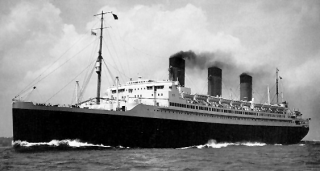 Her construction was part of the agreement between the
French Line (Compagnie Générale Transatlantique) and the French
government dating back to November 1912. This agreement called for
four passenger and mail liners, to be constructed in 1916, 1921, 1926,
and 1931. The first, Paris, was laid down in 1914, but
World War I disrupted her construction, and so she wasn't finished until
June 1921. As a result, Ile de France, the second ship, was
pushed back to 1926.
Her construction was part of the agreement between the
French Line (Compagnie Générale Transatlantique) and the French
government dating back to November 1912. This agreement called for
four passenger and mail liners, to be constructed in 1916, 1921, 1926,
and 1931. The first, Paris, was laid down in 1914, but
World War I disrupted her construction, and so she wasn't finished until
June 1921. As a result, Ile de France, the second ship, was
pushed back to 1926.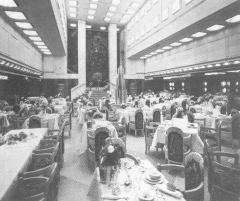 In her first-class cabins, there were so many
different styles of decoration that each was considered to be unique.
Her bar was claimed as the largest afloat, and her main restaurant, also
largest afloat, rose three decks high, and had a grand staircase for an
entrance. This dining room can be seen in the picture at right.
Her grand foyer rose four decks, and the chapel was done in gothic style
with fourteen pillars. Furthermore, the ship had a shooting
gallery, a merry-go-round, and a gymnasium.
In her first-class cabins, there were so many
different styles of decoration that each was considered to be unique.
Her bar was claimed as the largest afloat, and her main restaurant, also
largest afloat, rose three decks high, and had a grand staircase for an
entrance. This dining room can be seen in the picture at right.
Her grand foyer rose four decks, and the chapel was done in gothic style
with fourteen pillars. Furthermore, the ship had a shooting
gallery, a merry-go-round, and a gymnasium.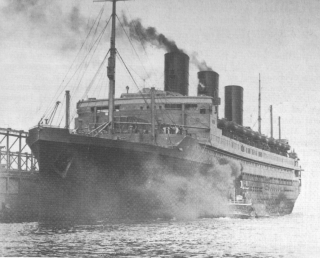 In September 1939, when World War II broke out, the
Ile de France was at New York's Pier 88, opposite the
Normandie. French Line had no intention to send her back to
France for fear of enemy advances. So the Ile de France was
towed to Staten Island, laid up again, and her staff of 800 was reduced
to 100. She was put on loan to the British Admiralty in March,
1940, and then on May 1, she was sent to Europe and then Singapore with
war materials. In the picture at left, she is seen starting her
first military voyage. Once she was in the far east, she was
formally seized by the British after the fall of France.
In September 1939, when World War II broke out, the
Ile de France was at New York's Pier 88, opposite the
Normandie. French Line had no intention to send her back to
France for fear of enemy advances. So the Ile de France was
towed to Staten Island, laid up again, and her staff of 800 was reduced
to 100. She was put on loan to the British Admiralty in March,
1940, and then on May 1, she was sent to Europe and then Singapore with
war materials. In the picture at left, she is seen starting her
first military voyage. Once she was in the far east, she was
formally seized by the British after the fall of France.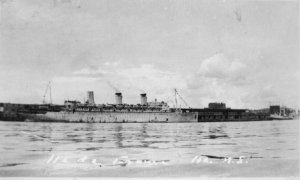 She was first based out of Saigon, and then later,
this was changed to Bombay. She worked with Cunard's second
Mauretania, and the Dutch Nieuw Amsterdam. These three
liners worked the Cape Town-to-Suez shuttle. Later, in 1943, she
was switched to the North Atlantic, and put under Cunard management.
Here she worked with the Compagnie Sud-Atlantique's Pasteur.
She was first based out of Saigon, and then later,
this was changed to Bombay. She worked with Cunard's second
Mauretania, and the Dutch Nieuw Amsterdam. These three
liners worked the Cape Town-to-Suez shuttle. Later, in 1943, she
was switched to the North Atlantic, and put under Cunard management.
Here she worked with the Compagnie Sud-Atlantique's Pasteur.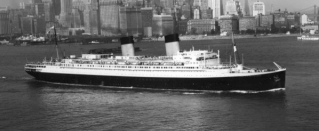 Two years later, she was substantially rebuilt, and
was practically a new ship. Her third "dummy" funnel came off, and
two new streamlined funnels were fitted to replace the other two.
Her berthing pattern was also modernized. And then on July 21,
1949, the new Ile de France departed from Le Havre to New York.
In August 1950, she, and her running mate De Grasse, were joined
by the 51,000-ton Liberté.
Two years later, she was substantially rebuilt, and
was practically a new ship. Her third "dummy" funnel came off, and
two new streamlined funnels were fitted to replace the other two.
Her berthing pattern was also modernized. And then on July 21,
1949, the new Ile de France departed from Le Havre to New York.
In August 1950, she, and her running mate De Grasse, were joined
by the 51,000-ton Liberté.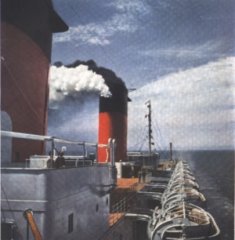 In 1958, the Ile de France had her 31st
birthday, but it wasn't exactly a happy one, unfortunately. Her
first-class trade had dwindled, as the airlines were winning over on the
North Atlantic, plus the usual problems of old age were setting in on
her. As a result, in November 1958, she left New York for the last
time.
In 1958, the Ile de France had her 31st
birthday, but it wasn't exactly a happy one, unfortunately. Her
first-class trade had dwindled, as the airlines were winning over on the
North Atlantic, plus the usual problems of old age were setting in on
her. As a result, in November 1958, she left New York for the last
time.